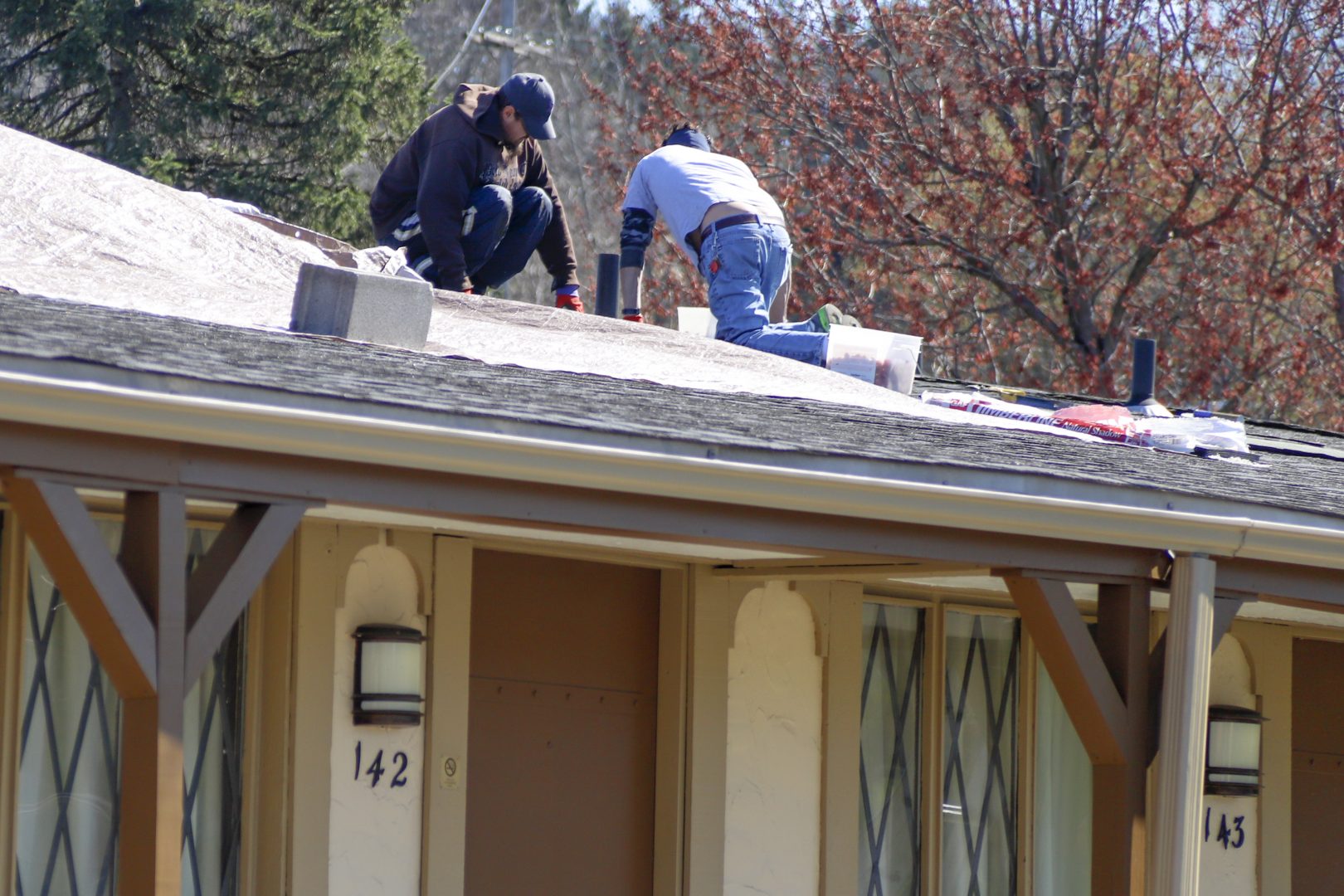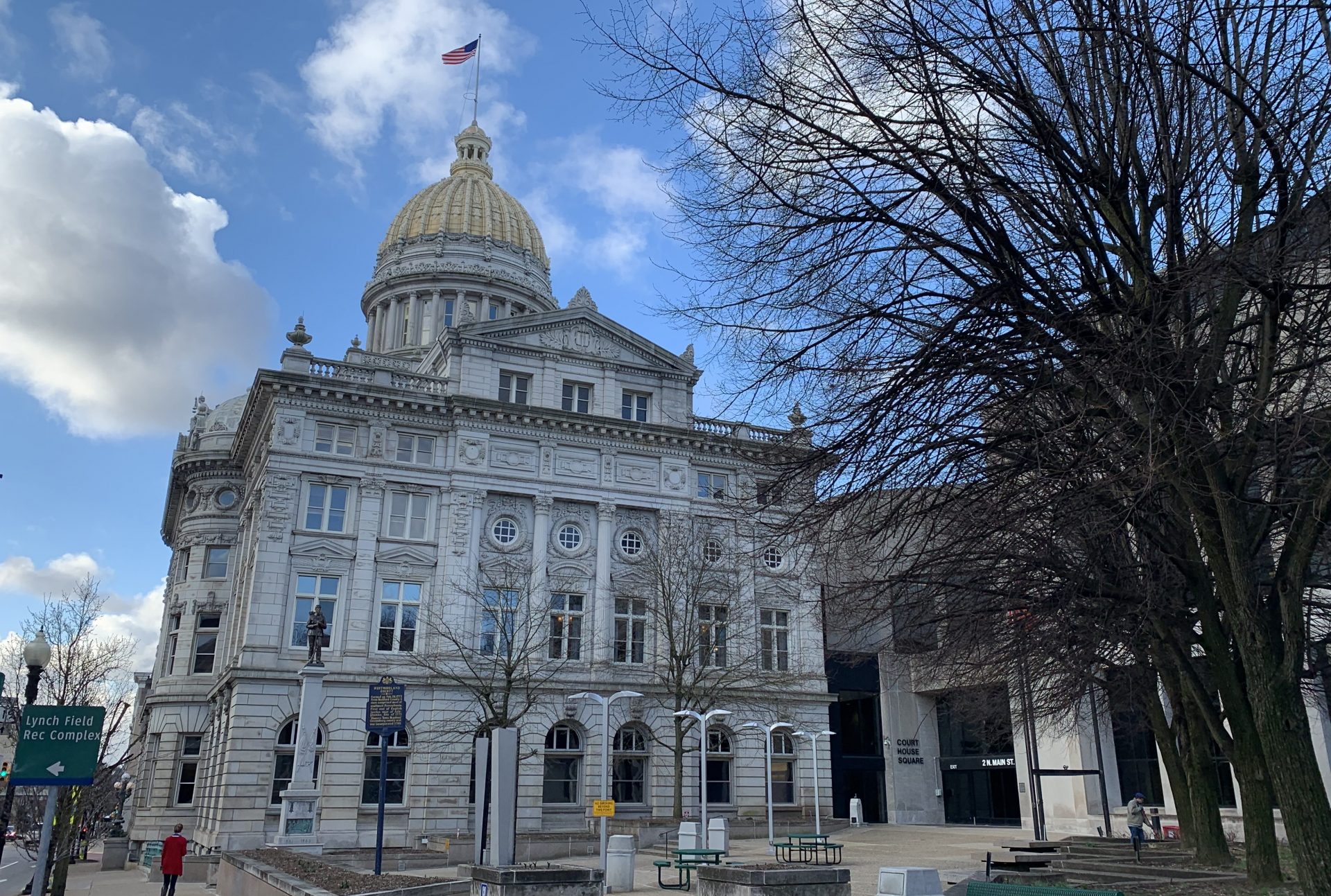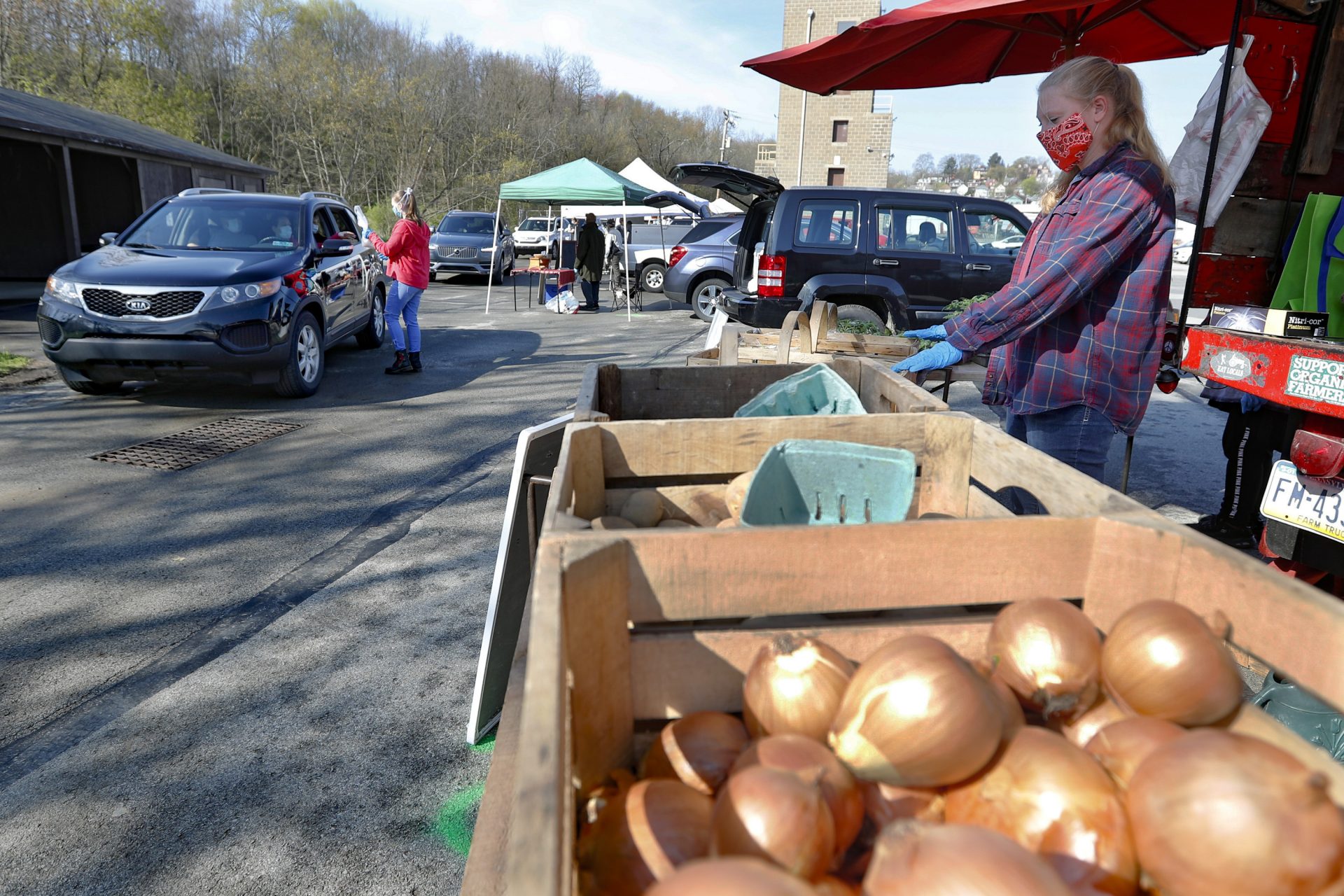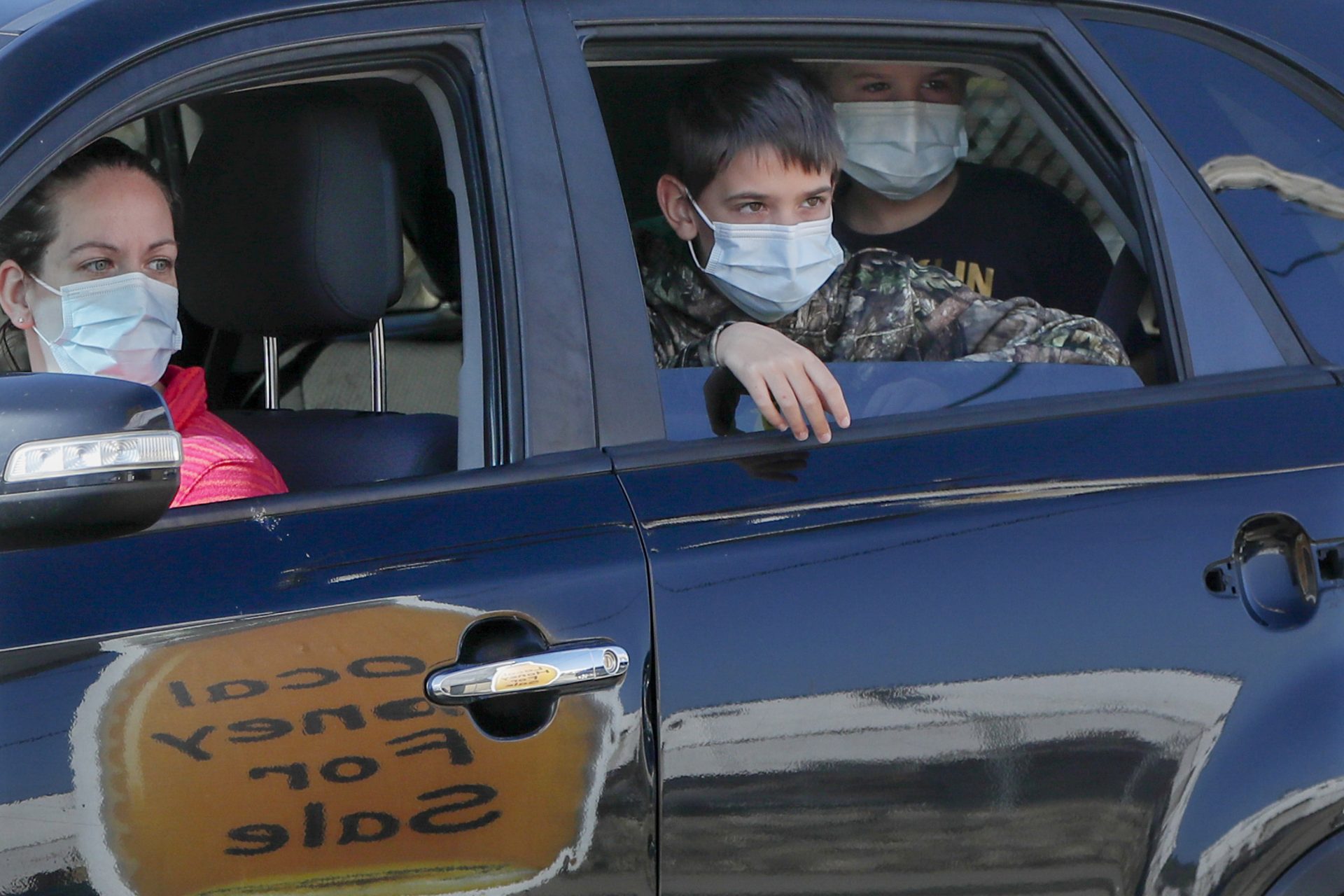
Roofers work on repairs at a motel in Greensburg, Pa. Thursday, April 2, 2020.
Keith Srakocic / AP Photo

Roofers work on repairs at a motel in Greensburg, Pa. Thursday, April 2, 2020.
Keith Srakocic / AP Photo

Keith Srakocic / AP Photo
Roofers work on repairs at a motel in Greensburg, Pa. Thursday, April 2, 2020.
(Greensburg) — Cora Jean Black doesn’t question why her once-white sheers are stained a “grizzly gray” that take up to six washes to restore their natural color.
The reason whirs by her daily in the form of big rigs and dump trucks either traveling along the sea of highways that snake through New Stanton or that are moving products to one of the many industries located in the borough.
“It’s just penetrating into the fabrics of everything,” she said of the vehicle exhaust. Black, 80, is owner of Sea-Jays Marriage Services on North Center Avenue.
Today’s reality is a far cry from the borough where Black grew up, a place she describes as family-oriented with homes dotting the landscape and dirt roads that, at least for Black, were used for sled riding in the winter. But as a stopping point between Somerset and Pittsburgh, New Stanton quickly became a transportation hub, an industry that was only amplified by the 1940 opening of the Pennsylvania Turnpike.
Today, businesses such as UPS, FedEX, Westinghouse, UNFI and the Municipal Authority of Westmoreland County attract workers who largely commute in and out daily. Dirt roads made way for paved highways that are conducive to trucking companies, leading to an influx of hotels, fast-food restaurants and gas stations.
“It’s a busy town, but it’s an in-and-out town,” Black said. “They get what they want and they’re gone.”
Over the past decade, New Stanton saw one of the largest population declines in Westmoreland County, losing almost 700 people between 2010 and 2019, according to data from the American Community Survey, which is collected every year by the Census Bureau. It is sent to a sample of people across the country, resulting in population estimates for years between the decennial census.
That population loss represents a 24% drop, or a decrease from about 2,900 people in 2010 to 2,200 in 2019. Jeff McLaughlin, borough manager, noted that while a new housing plan is underway, there has been a lack of new construction over the past decade. That, along with people having smaller families, are just some factors that could have led to the borough’s decline.
Still, New Stanton is not the only area facing these issues. Communities across the county have seen declines over the past several decades as the region grapples with the reality of being present-day Rust Belt towns largely filled with aging populations.

Emily Previti / PA Post
The Westmoreland County courthouse in Greensburg.
Over the past decade, Westmoreland County lost about 13,250 people, data show. That lowered the county’s population to 352,590 in 2019, similar to its population in the 1960s.
Local leaders are working to buck the trend with the help of a 2018 comprehensive plan aimed at building a community and environment where people would want to live.
Population declines across the region are largely traced back to the collapse of the steel industry in the 1980s, said Chad Amond, president and CEO of the Westmoreland County Chamber of Commerce. In 1980, the county recorded its peak population at 392,294 residents.
When the steel and auto industries plummeted — including a Volkswagen plant in East Huntingdon and Hempfield that shuttered in 1988, leaving about 2,500 people out of work — individuals and families were forced to leave the county, region and sometimes state in large waves to find new employment.
“Those that moved were those that would have been having kids at that time,” said Jason Rigone, the county’s director of planning and development. “That then had another effect of those kids would have been having kids now.”
As birth rates declined in the county, an issue seen across the country, populations continued to steadily drop. By 1990, Westmoreland had 370,321 residents — marking the county’s first population decline of that century, census data show. By 2000, the county had a population of 369,993, which dropped again in 2010 to 365,169 residents.
Today, Westmoreland residents are generally older. By 2019, there were 78,061 people older than 65 living in the county. That was up from 68,037 in 2010.
As things stand, populations are continually declining as natural deaths outpace births. Census data released in April 2019 showed Westmoreland had the highest number of natural deaths (11,210) in Pennsylvania from 2010-18.
“Our mortality rate is outpacing our birth rate,” Rigone said. “It’s a sign of the times, people are changing. They just don’t have as many kids as they once did, and that’s OK, but it has an effect on our population.”
A drop in population in recent years also has come as jobs left the county.
Sony Corp., which in 1992 opened at the former Volkswagen plant, shuttered in 2009 as part of a global downsizing, leaving 560 people out of work. In 2010, Westinghouse Electric in Monroeville moved to Cranberry. In its heyday, the headquarters consisting of two office complexes employed about 3,000 people.
Chris Briem, a regional economist at the University of Pittsburgh, noted many workers at the complex likely lived across the line in Westmoreland County.
Philips Sleep and Respiratory Care in 2018 moved 1,250 regional employees to new Bakery Square offices in Pittsburgh’s East End. The company did keep its manufacturing facilities in Murrysville and Upper Burrell along with a service center in Mt. Pleasant Township.
“That’s a big hit,” Briem said of those jobs moving to Allegheny County.
With several factors supporting population declines in the county, those numbers could only continue to decrease over the next few decades.
The Center for Rural Pennsylvania seven years ago predicted Westmoreland’s population could drop to 344,230 by 2040.
“You drop a stone in the water, and it creates ripples,” Rigone said. “We’re kind of seeing the second ripple of that industry closure back in the ’80s.”

AP Photo/Keith Srakocic
Workers from Sarver farms, right, wear protective masks, beside the onions, potatoes and vegetables they are selling to patrons driving by in their cars at the Greensburg Farmers’ Market opening day, Saturday, April 25, 2020, in Greensburg, Pa. Nearly a dozen vendors sold from tents in the parking lot of the Lynch Field Park for a farmers market set up for the patrons to stay in their cars and drive from one vendor to the next to follow safety protocols during the COVID-19 pandemic.
Across the county, cities and towns once bustling with small businesses supported by workers from local industries now sit empty, ghosts of what used to be.
In Jeannette, as many as 700 buildings are vacant, according to fire Chief Bill Frye. “Glass City,” which was founded on the glass manufacturing industry, has declined since the sprawling Jeannette Glass facility shuttered 1983, cutting 1,500 jobs.
Over the past decade, Jeannette lost 624 residents, data show, dropping from a population of 9,840 in 2010 to 9,216 in 2019, or a 6% decline. In 1900, the city had about 5,900 residents. That ballooned to more than 16,500 in 1960, census figures show.
“When you have 17,000 people living here and now you’re down to 9,200, you’re going to have empty buildings,” Mayor Curtis Antoniak said.
City leaders are hopeful the Elliott Group’s new $60 million testing facility on part of the former Jeannette Glass space will help revitalize the city and restore some of its former glory.
“I’m 61 years old, so I was there when Jeannette was booming,” Antoniak said. “But we’re not the only town, it’s everywhere across Western Pennsylvania. People just have to drive around and see the results of it.”
Across the county, similar scenes are visible in places such as Greensburg, which lost 747 people, or almost 5% of the population, and Monessen, a former steel city, which lost 519 people in the past decade, or about 6% of its population.
Most counties in the region saw population decreases in the decade. That includes Fayette (which lost 7,505 people), Somerset (3,858), Indiana (3,713) and Armstrong (3,622). Allegheny County, which is largely stabilizing as it attracts younger generations and several technology-based industries, saw its population decrease by 1,322 people.
Still, Western Pennsylvania is not alone in its struggles to maintain populations. Nationally, populations have gradually slowed every year since 2015, the census report shows.
Like Westmoreland, those trends are largely highlighted by aging populations, according to a January report from the Brookings Institution, which states that between 2010 and 2020 the number of people older than 55 grew by 27%. According to the report, the largest driver in aging populations is the baby boomer generation, who passed the age of 65 in the past decade.

Keith Srakocic / AP Photo
Members of the Folman family from Murrysville, Pa., wear protective masks in their car as they look at a table with honey for sale at the Greensburg Farmers’ Market opening day, Saturday, April 25, 2020, in Greensburg, Pa. Nearly a dozen vendors sold from tents in the parking lot of the Lynch Field Park for a farmers market set up for the patrons to stay in their cars and drive from one vendor to the next to follow safety protocols during the COVID-19 pandemic.
While those numbers seemingly paint a grim picture for the future of Westmoreland, pockets of growth can be seen across the county.
Located along the Westmoreland-Allegheny line and almost a straight shot to Downtown Pittsburgh, North Huntingdon has become a modest hub of growth, bucking trends seen in the rest of the county as single-family homes are continually built.
Over the past decade, the township grew by 120 people, bringing its population to 30,430 in 2019, data show. Those numbers seemingly piggyback off commercial growth and an average of about 104 new homes built each year over the past 20 years, according to Ryan Fonzi, the township’s director of planning and zoning.
Fonzi attributed the growth to “the proximity to Pittsburgh and the benefit of being in Westmoreland County and not having the higher taxes of Allegheny County.”
Next door, Manor also showed growth over the past decade with 173 new residents. The borough also had two new housing developments — Woods of Brandywine and Crimson Pointe — built in the past 10 years.
While the municipality actually saw a slight decrease in populations over the past decade, Murrysville is another area that benefited from its location along the county line, according to Chief Administrator James Morrison.
He said the municipality saw growth starting in the early 2000s after Route 22 was rebuilt. Since then, Murrysville has seen both commercial and residential developments.
“I think it’s a good, sound residential community and that’s the reason why people are attracted here,” Morrison said. “The school district is solid and that’s why they’re attracted here. It’s the quality of life here in the community.”
Upper Burrell saw one of the largest gains in the county, growing by 330 people, or 16%. That brought the township’s population from 2,056 in 2010 to 2,386 in 2019, data show. Township Secretary Melissa Cortileso attributes the growth to a housing plan built in the early 2000s and to low taxes.
“For small municipalities, population growth is often really driven by specific new housing developments,” Briem said. “Of course, there is a bigger question of what is driving those investments, but, really, if there was notable growth in a specific small area, it is net new housing.”

Keith Srakocic / AP Photo
In this photo made on, April 2, 2020, nurse anesthetist Jessica Poole checks for updates on the coronavirus pandemic in her home office in Greensburg, Pa. Poole, until a couple weeks ago, worked for a private anesthesia practice that serves the Pittsburgh area until she was laid off. She is one of the tens of thousands of medical workers across the United States suddenly out of work as operating rooms and doctor’s offices go dark, casualties of urgent calls to prioritize coronavirus patients at overwhelmed hospitals and of the economic waves the crisis is churning.
County leaders have been working to capitalize on that growth in an attempt to stabilize population declines.
The 2018 plan, Reimagine Our Westmoreland, lays out several factors to make the county attractive for businesses as well as younger people.
The 10-year plan is the second adopted by the county, Rigone said. A 2005 plan focused on challenges in terms of infrastructure and economic development.
The new version, Rigone said, “really (focuses) on the problem statement of population decline. The strategies associated with addressing that really were about creating a community and an environment people would want to stay or would want to move to.”
That can be achieved by leveraging local talent, focusing on small businesses and connecting with technology, according to the plan.
Other aspects include creating development-ready sites, cultivating arts and entertainment, honing in on the county’s rural aspects, developing recreation sites and enhancing trail systems.
Making the county an attractive place to live, Briem said, will likely draw people to the area, even if their job is elsewhere. The area’s roadways make it fairly simple to commute for work to one of the seven surrounding counties — Allegheny, Armstrong, Butler, Fayette, Indiana, Somerset and Washington.
“We’re not as isolated as we might have been a century ago, where jobs and the workers were so tied together,” Briem said.
Still, aspects of the plan include bolstering manufacturing jobs, as well as producing skilled labor through trade schools.
The former Sony plant is now home to tenants such as DNP IMS America, Cenveo, Westmoreland County Community College, Siemens and ARGO. Rigone noted county officials are hopeful the site soon will be home to more workers than were previously employed there.
“That takes time to build. That doesn’t happen overnight,” Rigone said. “Population numbers don’t change quickly, so we’re really building a foundation for success that we’re hoping we’ll actually see progress on toward the end of that plan’s term.”
Small efforts by municipalities could help in the overall goal of making Westmoreland County attractive to both younger generations as well as to people already living in the area.
New Stanton leaders are hopeful initiatives such as putting in sidewalks and a new housing development, which will add 167 single-family homes over 10 years, will help bring people to the borough.
“We are trying to make it more livable, more walkable,” McLaughlin said. “Certainly, our park, we’re proud of that. It goes toward quality of life, so we try to maintain that.”
Rigone noted efforts by county partners, both nonprofits and those in the private sector, are helping to identify areas that need support in terms of population growth, meaning the county has “some very strong momentum moving forward.”
And while populations are smaller than they were a decade ago, Briem stressed that does not mean the county cannot still be successful.
“Certain communities are smaller than they were at their peak, or in the past, but nonetheless can be very successful places, where families want to live or work or where new jobs are being created,” Briem said.
Looking forward, Rigone added, “We’re excited for the future, but this is a process that we have to be patient, we have to be persistent, we have to obviously look for partnerships to ensure we are successful.”
——————————————————————————————————————————————————
DETAILS
Up and down
Of municipalities in Westmoreland County with 1,000 residents or more, here are the ones that saw the most growth and the most losses in population from 2010 to 2019.
Gains
Upper Burrell 16% (2,386; +330)
Loyalhanna 11% (1,972; +197)
Manor 5.5% (3,318; +173)
South Greensburg 4% (2,162; +91)
West Leechburg 2.5% (1,511; +38)
Losses
New Stanton 23.9% (2,199; -694)
Fairfield 19% (2,099; -496)
St. Clair 13.7% (1,351; -215)
Derry Borough 7.8% (2,540; -217)
Ligonier 7.6% (1,405; -116)
Source: U.S. Census Bureau
The days of journalism’s one-way street of simply producing stories for the public have long been over. Now, it’s time to find better ways to interact with you and ensure we meet your high standards of what a credible media organization should be.